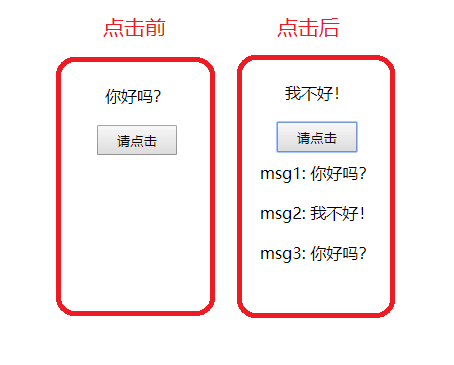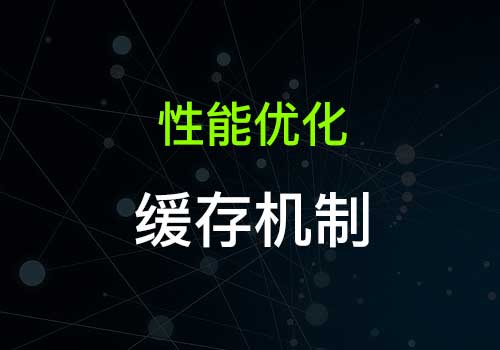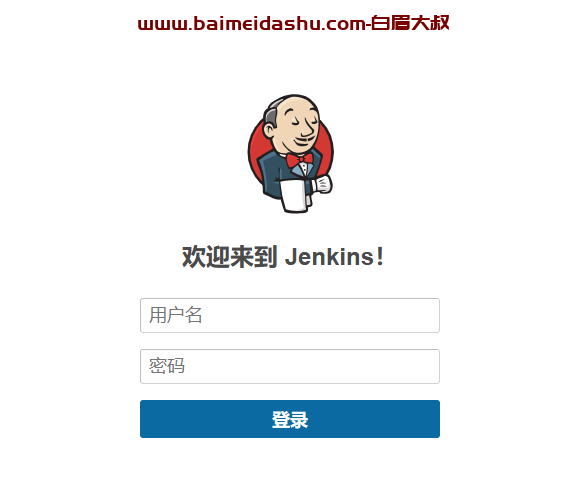文章已同步至掘金:https://juejin.cn/post/6844903962039025678
欢迎访问?,有任何问题都可留言评论哦~
在看这篇文章之前,推荐先看一下这篇文章:JS(浏览器)事件环 (宏、微任务)
你需要了解一下 JS的运行机制,和微宏任务的执行顺序
示例 {#%E7%A4%BA%E4%BE%8B}
先写一个示例了解下关于 Vue中的DOM更新以及nextTick的作用。
<template>
<div id="app">
<div ref="msg">{{msg}}</div>
<div>
<button @click="change()">
请点击
</button>
</div>
<div v-if="msg1">msg1: {{msg1}}</div>
<div v-if="msg2">msg2: {{msg2}}</div>
<div v-if="msg3">msg3: {{msg3}}</div>
</div>
</template>
`<script>
export default {
data() {
return {
msg: "你好吗?",
msg1: "",
msg2: "",
msg3: ""
};
},
methods: {
change() {
this.msg = "我不好!"; //改变msg的数据
this.msg1 = this.$refs.msg.innerHTML; //拿到msg的数据给msg1
this.$nextTick(() => {
this.msg2 = this.$refs.msg.innerHTML; //使用$nextTick把msg的数据给msg2
});
this.msg3 = this.$refs.msg.innerHTML; //拿到msg的数据给msg3
}
}
};
</script>
`
运行效果:

从图中可以得知:msg1和msg3显示的内容还是变换之前的,而msg2显示的内容是变换之后的。
根本原因是因为Vue中DOM更新是异步的(下面说)。
原理 {#%E5%8E%9F%E7%90%86}
Vue 官方对nextTick这个API的描述:
在下次 DOM 更新循环结束之后执行延迟回调。在修改数据之后立即使用这个方法,获取更新后的 DOM。
因为Vue实现响应式并不是数据发生变化之后 DOM 立即变化,而是按一定的策略进行 DOM 的更新。
在 Vue 的文档中,说明Vue是异步执行 DOM 更新的。
简单来说,Vue在修改数据后,视图不会立刻更新,而是等同一事件循环中的所有数据变化完成之后,再统一进行视图更新。
用途 {#%E7%94%A8%E9%80%94}
应用场景:需要在视图更新之后,基于新的视图进行操作。
在Vue生命周期中的created()钩子函数进行的DOM操作一定要放在Vue.nextTick()的回调函数中
因为在created()钩子函数执行的时候DOM其实并未进行任何渲染,而此时进行DOM操作无异于徒劳,所以此处一定要将DOM操作的js代码放进Vue.nextTick()的回调函数中。
与之对应的就是mounted()钩子函数,因为该钩子函数执行时所有的DOM挂载和渲染都已完成,此时在该钩子函数中进行任何DOM操作都不会有问题 。
但是需要注意一点:mounted不会承诺所有的子组件也都一起被挂载。如果你希望等到整个视图都渲染完毕,可以用 vm.$nextTick 替换掉 mounted
mounted: function () {
this.$nextTick(function () {
// Code that will run only after the
// entire view has been rendered
})
}
在数据变化后要执行的某个操作,而这个操作需要使用随数据改变而改变的DOM结构的时候,这个操作都应该放进Vue.nextTick()的回调函数中。(正如上面的代码示例所演示的那样)
官方说明:
Vue 异步执行 DOM 更新。只要观察到数据变化,Vue 将开启一个队列,并缓冲在同一事件循环中发生的所有数据改变。如果同一个 watcher 被多次触发,只会被推入到队列中一次。这种在缓冲时去除重复数据对于避免不必要的计算和 DOM 操作上非常重要。然后,在下一个的事件循环"tick"中,Vue 刷新队列并执行实际 (已去重的) 工作。Vue 在内部尝试对异步队列使用原生的
Promise.then和MessageChannel,如果执行环境不支持,会采用setTimeout(fn, 0)代替。 例如,当你设置vm.someData = 'new value',该组件不会立即重新渲染。当刷新队列时,组件会在事件循环队列清空时的下一个"tick"更新。多数情况我们不需要关心这个过程,但是如果你想在 DOM 状态更新后做点什么,这就可能会有些棘手。虽然 Vue.js 通常鼓励开发人员沿着"数据驱动"的方式思考,避免直接接触 DOM,但是有时我们确实要这么做。为了在数据变化之后等待 Vue 完成更新 DOM ,可以在数据变化之后立即使用Vue.nextTick(callback)。这样回调函数在 DOM 更新完成后就会调用。
源码 {#%E6%BA%90%E7%A0%81}
Vue.nextTick用于延迟执行一段代码,它接受2个参数(回调函数和执行回调函数的上下文环境),如果没有提供回调函数,那么将返回promise对象。
2.5版本 {#2.5%E7%89%88%E6%9C%AC}
/* @flow */
/* globals MessageChannel */
import { noop } from 'shared/util'
import { handleError } from './error'
import { isIOS, isNative } from './env'
const callbacks = []
let pending = false
function flushCallbacks () {
pending = false
const copies = callbacks.slice(0)
callbacks.length = 0
for (let i = 0; i < copies.length; i++) {
copies
}
}
// 在2.4中使用了microtasks ,但是还是存在问题,
// 在2.5版本中组合使用macrotasks和microtasks,组合使用的方式是对外暴露withMacroTask函数
// Here we have async deferring wrappers using both microtasks and (macro) tasks.
// In < 2.4 we used microtasks everywhere, but there are some scenarios where
// microtasks have too high a priority and fire in between supposedly
// sequential events (e.g. #4521, #6690) or even between bubbling of the same
// event (#6566). However, using (macro) tasks everywhere also has subtle problems
// when state is changed right before repaint (e.g. #6813, out-in transitions).
// Here we use microtask by default, but expose a way to force (macro) task when
// needed (e.g. in event handlers attached by v-on).
// 2.5版本在nextTick中对于调用microtask(微任务)还是macrotask(宏任务)声明了两个不同的变量
let microTimerFunc
let macroTimerFunc
// 默认使用microtask(微任务)
let useMacroTask = false
// 这里主要定义macrotask(宏任务)函数
// macrotask(宏任务)的执行优先级
// setImmediate -> MessageChannel -> setTimeout
// setImmediate是最理想的选择
// 最Low的状况是降级执行setTimeout
// Determine (macro) task defer implementation.
// Technically setImmediate should be the ideal choice, but it's only available
// in IE. The only polyfill that consistently queues the callback after all DOM
// events triggered in the same loop is by using MessageChannel.
/* istanbul ignore if /
if (typeof setImmediate !== 'undefined' && isNative(setImmediate)) {
macroTimerFunc = () => {
setImmediate(flushCallbacks)
}
} else if (typeof MessageChannel !== 'undefined' && (
isNative(MessageChannel) ||
// PhantomJS
MessageChannel.toString() === '[object MessageChannelConstructor]'
)) {
const channel = new MessageChannel()
const port = channel.port2
channel.port1.onmessage = flushCallbacks
macroTimerFunc = () => {
port.postMessage(1)
}
} else {
/ istanbul ignore next */
macroTimerFunc = () => {
setTimeout(flushCallbacks, 0)
}
}
// 这里主要定义microtask(微任务)函数
// microtask(微任务)的执行优先级
// Promise -> macroTimerFunc
// 如果原生不支持Promise,那么执行macrotask(宏任务)函数
// Determine microtask defer implementation.
/* istanbul ignore next, $flow-disable-line */
if (typeof Promise !== 'undefined' && isNative(Promise)) {
const p = Promise.resolve()
microTimerFunc = () => {
p.then(flushCallbacks)
// in problematic UIWebViews, Promise.then doesn't completely break, but
// it can get stuck in a weird state where callbacks are pushed into the
// microtask queue but the queue isn't being flushed, until the browser
// needs to do some other work, e.g. handle a timer. Therefore we can
// "force" the microtask queue to be flushed by adding an empty timer.
if (isIOS) setTimeout(noop)
}
} else {
// fallback to macro
microTimerFunc = macroTimerFunc
}
// 对外暴露withMacroTask 函数
// 触发变化执行nextTick时强制执行macrotask(宏任务)函数
/**
-
Wrap a function so that if any code inside triggers state change,
-
the changes are queued using a (macro) task instead of a microtask.
*/
export function withMacroTask (fn: Function): Function {
return fn._withTask || (fn._withTask = function () {
useMacroTask = true
try {
return fn.apply(null, arguments)
} finally {
useMacroTask = false
}
})
}
// 这里需要注意pending export function nextTick (cb?: Function, ctx?: Object) { let _resolve callbacks.push(() => { if (cb) { try { cb.call(ctx) } catch (e) { handleError(e, ctx, 'nextTick') } } else if (_resolve) { _resolve(ctx) } }) if (!pending) { pending = true if (useMacroTask) { macroTimerFunc() } else { microTimerFunc() } } // $flow-disable-line if (!cb && typeof Promise !== 'undefined') { return new Promise(resolve => { _resolve = resolve }) } }
2.6版本 {#2.6%E7%89%88%E6%9C%AC}
/* @flow */
/* globals MutationObserver */
import { noop } from 'shared/util'
import { handleError } from './error'
import { isIE, isIOS, isNative } from './env'
export let isUsingMicroTask = false
const callbacks = []
let pending = false
function flushCallbacks () {
pending = false
const copies = callbacks.slice(0)
callbacks.length = 0
for (let i = 0; i < copies.length; i++) {
copies
}
}
// 在2.5版本中组合使用microtasks 和macrotasks,但是重绘的时候还是存在一些小问题,而且使用macrotasks在任务队列中会有几个特别奇怪的行为没办法避免,So又回到了之前的状态,在任何地方优先使用microtasks 。
// Here we have async deferring wrappers using microtasks.
// In 2.5 we used (macro) tasks (in combination with microtasks).
// However, it has subtle problems when state is changed right before repaint
// (e.g. #6813, out-in transitions).
// Also, using (macro) tasks in event handler would cause some weird behaviors
// that cannot be circumvented (e.g. #7109, #7153, #7546, #7834, #8109).
// So we now use microtasks everywhere, again.
// A major drawback of this tradeoff is that there are some scenarios
// where microtasks have too high a priority and fire in between supposedly
// sequential events (e.g. #4521, #6690, which have workarounds)
// or even between bubbling of the same event (#6566).
let timerFunc
// The nextTick behavior leverages the microtask queue, which can be accessed
// via either native Promise.then or MutationObserver.
// MutationObserver has wider support, however it is seriously bugged in
// UIWebView in iOS >= 9.3.3 when triggered in touch event handlers. It
// completely stops working after triggering a few times... so, if native
// Promise is available, we will use it:
/* istanbul ignore next, $flow-disable-line */
// task的执行优先级
// Promise -> MutationObserver -> setImmediate -> setTimeout
if (typeof Promise !== 'undefined' && isNative(Promise)) {
const p = Promise.resolve()
timerFunc = () => {
p.then(flushCallbacks)
// In problematic UIWebViews, Promise.then doesn't completely break, but
// it can get stuck in a weird state where callbacks are pushed into the
// microtask queue but the queue isn't being flushed, until the browser
// needs to do some other work, e.g. handle a timer. Therefore we can
// "force" the microtask queue to be flushed by adding an empty timer.
if (isIOS) setTimeout(noop)
}
isUsingMicroTask = true
} else if (!isIE && typeof MutationObserver !== 'undefined' && (
isNative(MutationObserver) ||
// PhantomJS and iOS 7.x
MutationObserver.toString() === '[object MutationObserverConstructor]'
)) {
// Use MutationObserver where native Promise is not available,
// e.g. PhantomJS, iOS7, Android 4.4
// (#6466 MutationObserver is unreliable in IE11)
let counter = 1
const observer = new MutationObserver(flushCallbacks)
const textNode = document.createTextNode(String(counter))
observer.observe(textNode, {
characterData: true
})
timerFunc = () => {
counter = (counter + 1) % 2
textNode.data = String(counter)
}
isUsingMicroTask = true
} else if (typeof setImmediate !== 'undefined' && isNative(setImmediate)) {
// Fallback to setImmediate.
// Techinically it leverages the (macro) task queue,
// but it is still a better choice than setTimeout.
timerFunc = () => {
setImmediate(flushCallbacks)
}
} else {
// Fallback to setTimeout.
timerFunc = () => {
setTimeout(flushCallbacks, 0)
}
}
export function nextTick (cb?: Function, ctx?: Object) { let _resolve callbacks.push(() => { if (cb) { try { cb.call(ctx) } catch (e) { handleError(e, ctx, 'nextTick') } } else if (_resolve) { _resolve(ctx) } }) if (!pending) { pending = true timerFunc() } // $flow-disable-line if (!cb && typeof Promise !== 'undefined') { return new Promise(resolve => { _resolve = resolve }) } }
 51工具盒子
51工具盒子




![[原创]Linux服务器出入口网络带宽速率测速Shell脚本](https://img1.51tbox.com/static/2024-11-01/TvtxpoUQGajd.jfif)